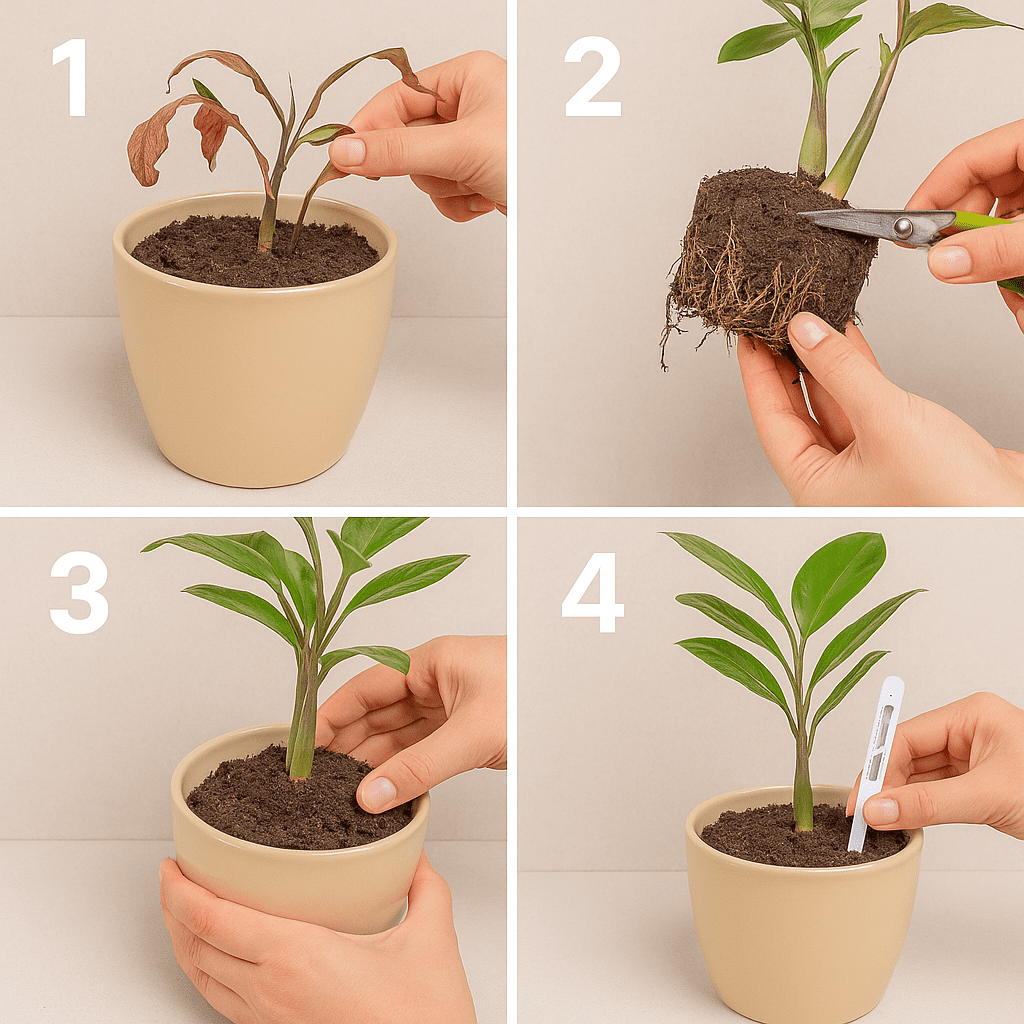Even the most dedicated plant lovers can face the heartbreaking moment when a once-thriving plant starts to wilt, brown, or drop leaves. If you’re staring at a sad-looking potted friend wondering if there’s still hope—there is. Learning how to revive a dying houseplant step by step can make all the difference between losing it and bringing it back to life.
In this guide, we’ll explore the most common causes of houseplant decline and walk through proven recovery methods to help your green companion thrive again.
Spotting the Warning Signs
Before jumping into action, observe your plant closely. The symptoms can tell you a lot about what’s wrong:
- Yellowing leaves: Often a sign of overwatering, poor drainage, or nutrient deficiency.
- Crispy or brown leaf edges: Usually from underwatering or low humidity.
- Droopy stems or wilting: Can mean root rot, underwatering, or shock.
- White fuzz or pests: Mealybugs, spider mites, or mold from poor airflow.
- Mushy stems: Likely from overwatering and root rot.
Identifying the issue is the first step toward revival.
Step-by-Step Guide to Revive a Dying Houseplant
Step 1: Assess Watering Habits
How to Check:
- Stick your finger into the soil up to 2 inches.
- If it feels soggy or smells musty, it’s likely overwatered.
- If it’s bone dry, the plant is dehydrated.
What to Do:
- For overwatered plants, remove from the pot and check the roots.
- Trim mushy, black roots and replant in fresh, dry soil.
- For dry plants, give a deep watering and mist gently.
Step 2: Improve Drainage
Plants need air just as much as water.
Fixes:
- Ensure your pot has a drainage hole.
- Add a layer of pebbles or broken terracotta at the bottom.
- Use a well-draining soil mix appropriate for your plant species.
Step 3: Evaluate Light Conditions
Plants in low light can become leggy and weak.
Actions:
- Move your plant closer to a bright window (but not direct sun unless it’s a sun-lover).
- Rotate the pot weekly to encourage even growth.
Step 4: Check for Pests
Use a magnifying glass if needed.
What to Look For:
- Small webs, white fuzzy spots, or sticky residue.
- Bugs under leaves or crawling on stems.
Remedies:
- Use neem oil, insecticidal soap, or a mixture of water and dish soap.
- Quarantine infected plants to prevent spread.
Step 5: Prune Damaged Areas
How:
- Use sterilized scissors to remove dead leaves and stems.
- Don’t remove all foliage; keep some green growth for photosynthesis.
Step 6: Repot If Necessary
If roots are circling the pot or compacted, it’s time to upgrade.
Tips:
- Choose a pot 1–2 inches larger in diameter.
- Use new soil to reduce disease risk.
- Water after repotting and place in a calm, bright spot.
Step 7: Monitor and Be Patient
Recovery doesn’t happen overnight.
Continue Care:
- Water only when topsoil is dry.
- Mist for humidity if needed.
- Fertilize lightly after 2–4 weeks of recovery.

Common Revival Mistakes to Avoid
- Overcompensating with water or fertilizer.
- Moving the plant too often (causes stress).
- Cutting too much during pruning.
- Using heavy or compact soil.
Tools That Can Help
- Moisture meter: To avoid over/underwatering.
- Grow lights: For spaces with low natural light.
- Neem oil: Natural and effective pest control.
For more tips on identifying and treating plant issues, check out our guide on common plant diseases and how to treat them.
Conclusion
Houseplants are surprisingly resilient. With observation, patience, and consistent care, most can bounce back from poor health. Now that you know how to revive a dying houseplant step by step, take action and bring your green friend back to life.
Save this guide for the next time a leaf starts to yellow—or share it with someone who’s struggling with their plant care routine!
FAQ
Q: How long does it take to revive a houseplant?
A: It depends on the plant and damage, but most take 2–6 weeks to show recovery signs.
Q: Should I fertilize a dying plant?
A: No. Wait until the plant shows new growth. Fertilizer can stress it further.
Q: Can all plants be saved?
A: Not always. If the roots are entirely rotten or there’s no green tissue left, it may be too late.
You can find quality indoor plant fertilizers and moisture meters here on Amazon.
Written by Kate Smith | Plant Care Enthusiast & Urban Gardener

[…] with a plant that looks beyond saving? Check out our detailed guide on how to revive a dying houseplant for proven recovery […]